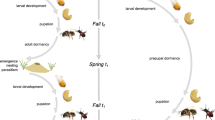Summary
Thirteen days of foraging studies, on normally developing colonies of Vespula vulgaris, were carried out between 5 July and 7 October over several years. Seven categories of workers were considered: two of outgoers – earth carriers and non-earth outgoers, and five of incomers – pulp, flesh, full fluid, and partial fluid carriers, and empty incomers. The pre-exponential small-cell colony is characterised by a more-or-less equal frequency of pulp and flesh carriers and a relatively high frequency of non-earth outgoers. These characteristics are related to the needs of a colony rapidly to build its worker population. The exponential small-cell colony is characterised by an increased frequency of earth and pulp carriers, with the latter being more frequent than flesh carriers. These characteristics are related to the enlargement of the nest cavity, the building of small cells and the decreasing weight of workers. The large-cell colony is characterised by a relative lack of earth and pulp carriers, with flesh carriers being more frequent than pulp carriers. The relative lack of earth carriers is probably because the large-celled combs occupy the nest cavity created during the exponential small-cell colony. The relative lack of pulp carriers is probably due to the re-use of pulp from discarded small cells for large cells. The percentage differences between early morning and evening worker categories compared with normal daily foraging (from Archer, 2000) are determined. Despite much variation, during the early morning there were relatively more full fluid carriers and relatively fewer flesh carriers. During the evening, there were relatively more partial fluid carriers and relatively fewer solid carriers. The dissolved component of the fluid is hypothesised to provide a food source to maintain a high, stable nest temperature.
Similar content being viewed by others
Author information
Authors and Affiliations
Corresponding author
Additional information
Received 20 March 2003; revised 10 November 2003; accepted 21 November 2003.
Rights and permissions
About this article
Cite this article
Archer, M.E. All-day foraging characteristics of successful underground colonies of Vespula vulgaris (Hymenoptera, Vespidae) in England. Insect. Soc. 51, 171–178 (2004). https://doi.org/10.1007/s00040-004-0731-7
Issue Date:
DOI: https://doi.org/10.1007/s00040-004-0731-7




